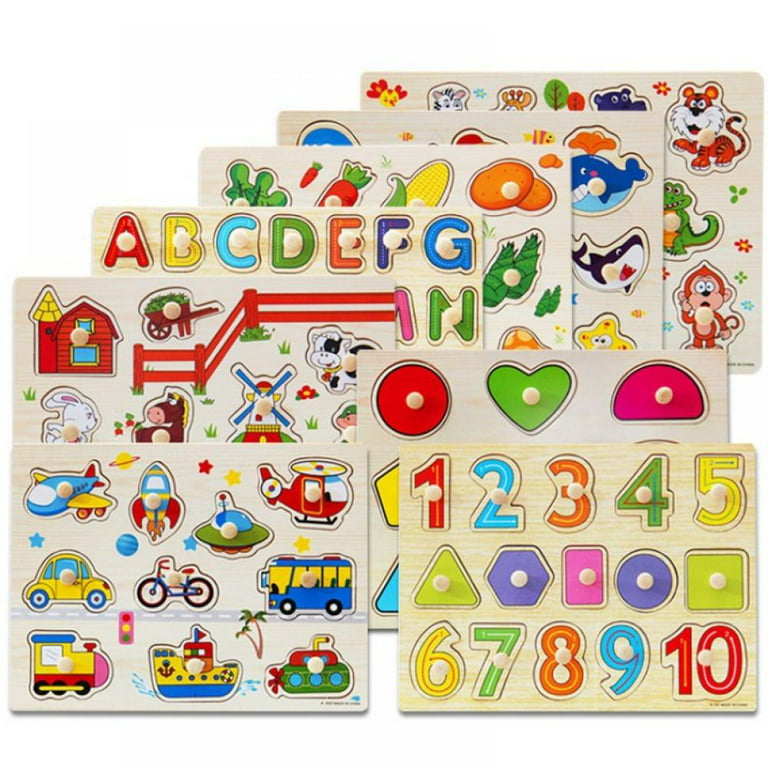Types of Puzzles Suited for Toddlers
Choosing the right kind of puzzles for toddlers can significantly impact their learning experience. Here are differing types, each with unique benefits:

Wooden Peg Puzzles
Wooden peg puzzles are a classic choice. They have small pegs on each piece, making it easy for tiny hands to grasp and maneuver. The clear, simple designs help toddlers recognize shapes and pictures. These puzzles are durable and can withstand rough play, making them a staple in the puzzle world for young children.
Chunky Puzzles
Chunky puzzles feature large, thick pieces that are perfect for toddlers. The pieces often stand up, allowing them to double as play figures for imaginative fun. These puzzles encourage hand-eye coordination and help little ones refine their pincer grasp, which is vital for writing skills later on.
Knob Puzzles
Knob puzzles are similar to wooden peg puzzles but have larger knobs that are easier for younger toddlers to handle. They often feature fewer pieces and more straightforward designs, ideal for beginners just starting to explore the world of puzzles. This type enhances spatial perception as toddlers learn to fit pieces into their exact places.
Floor Puzzles
Floor puzzles are large, engaging, and often feature colorful designs that captivate a toddler’s attention. As these puzzles spread out on the floor, they encourage gross motor skills along with cognitive development. Children love the challenge of working on a big scale, and these puzzles provide a great opportunity for family interaction and cooperative play.
Each of these puzzles for toddlers supports different stages of development. By matching the puzzle to the toddler’s age, skill level, and interests, parents and caregivers can help foster a love for challenges and create a fun learning environment.

Benefits of Puzzle Play for Toddlers
Engaging toddlers with puzzles is not just about keeping them busy. The benefits are many and vital to their growth. As they solve puzzles, toddlers develop in several key areas.
Cognitive Development
Puzzles for toddlers are powerful tools for cognitive growth. They encourage toddlers to recognize patterns and understand how pieces fit together. Cognitive skills like memory, concentration, and reasoning get a good workout. As toddlers look at different pieces and figure where they go, they learn about colors, shapes, and sizes. This type of learning lays the groundwork for the future.
Problem-Solving Skills
When a toddler figures out a puzzle, they are solving a problem. Each time they find where a piece goes, they learn to solve challenges by trial and error. This builds their confidence and resilience. Problem-solving also teaches toddlers to have patience and to keep trying until they succeed. These are important life skills that will help them in school and beyond.
Fine Motor Skills Improvement
Puzzles are perfect for improving fine motor skills. Toddlers use their fingers to pick up, pinch, and place puzzle pieces. This practice is essential for developing the fine motor skills they will need for writing. It also aids in hand-eye coordination. By turning and fitting pieces into their places, toddlers gain control over their hand movements.

Selecting the Right Puzzle for Your Toddler
Choosing the perfect puzzle for your toddler is key to their learning and enjoyment. Here’s how to select the right one:
Age Appropriateness
It’s essential to consider your child’s age when picking out puzzles for toddlers. Puzzles range from simple shapes and colors for the youngest children to more complex designs for older toddlers. Look for puzzles that match your child’s developmental level to keep them both challenged and engaged.
Material and Durability
Toddlers can be tough on toys, so durability matters. Wooden puzzles are sturdy and can take the wear and tear. Also, ensure the materials used are non-toxic and safe for kids. Durable puzzles will not only last longer but will also be safer for your child to handle.
Educational Value
Every puzzle should offer more than just fun. They should have an educational aspect to help with your child’s development. Choose puzzles for toddlers that teach shapes, colors, numbers, or even the alphabet. Puzzles that mirror real-life objects help kids understand their environment better.
Incorporating Puzzles into Everyday Play
Incorporating puzzles into a toddler’s everyday play routine can significantly enhance their cognitive and motor skills development. Parents and caregivers can set up a dedicated puzzle corner or integrate interactive puzzle games to make this activity a staple of daily play. Here’s how to effectively achieve this:
Creating a Puzzle Corner
Designate a special area in your home as the puzzle corner for your toddler. This should be a safe, comfortable space with a child-sized table and storage for different types of puzzles for toddlers. Keep the area well-lit and inviting, with a soft mat or carpet on the floor for those larger floor puzzles. The accessibility of the puzzle corner encourages toddlers to play independently, fostering creativity and self-learning.
Some steps to set up a puzzle corner include:
- Selecting a low shelf or bin where toddlers can reach puzzles on their own.
- Displaying a variety of puzzles, including peg, knob, and chunky puzzles, catering to the toddler’s growing skills.
- Frequently changing the available puzzles to maintain interest and introduce new learning opportunities.
Interactive Puzzle Games
Interactive puzzle games are a fun way to boost a toddler’s engagement with puzzles. They involve more than just traditional solo play and can include family or peer interactions. For instance, setting up puzzle races, where toddlers race to complete a puzzle, adds excitement and a sense of healthy competition to the activity. Another interactive game could involve a puzzle treasure hunt where pieces are hidden around the house, and toddlers must find them before assembling the puzzle.
Interactive puzzle games you might try are:
- ‘Puzzle Match-up’ where toddlers pair puzzle pieces with corresponding images on flashcards.
- ‘Color Coded’ puzzles where toddlers group pieces by color before tackling the assembly.
- ‘Puzzle Story-time’ where each puzzle completion is accompanied by a story related to the image formed.
By regularly incorporating puzzles for toddlers into their playtime, children remain intrigued and challenged, leading to continuous learning and development. Take care, though, to tailor these activities to the child’s age and ability to ensure they’re both fun and beneficial.
Safety Considerations When Choosing Toddler Puzzles
Choosing safe puzzles for toddlers is vital for their health and safety. Here are key safety features to look for:
Non-toxic Materials
Always check that puzzles for toddlers use non-toxic materials. Toddlers often put things in their mouths. Safe materials prevent the risk of poisoning. Look for labels that confirm safety standards. They should say “non-toxic” or have approval from reputable safety organizations. Avoid puzzles with harmful chemicals or lead-based paints.
Large Pieces to Prevent Choking
Toddlers are at a stage where they can choke on small objects easily. It’s crucial to pick puzzles with large pieces that are too big to swallow. Check that the pieces cannot fit through a toilet paper roll; this is a good test for size. If it fits through, it is too small. Especially with toddlers, the bigger the piece, the safer it is. This careful selection can help prevent any choking accidents.
Tips to Encourage Engagement in Puzzle Play
To keep toddlers interested and motivated in puzzle play, certain strategies can prove to be effective. Here are some tips to help encourage engagement and make puzzle time both educational and enjoyable for the little ones.
Guided Play Sessions
Lead by example and join in on the fun. Sit with your toddler and work on a puzzle together. This not only provides them with companionship but also gives you the opportunity to guide them subtly. Show them how to find the right pieces and praise their successes to boost their confidence.
- Start with simple puzzles and gradually increase complexity.
- Break down the steps for them; find edges first, then fill in the middle.
- Offer hints, but don’t complete the puzzle for them.
Guided play helps toddlers feel supported and can be a great bonding experience. Plus, it gives you a chance to teach them techniques and puzzle-solving strategies.
Regular Rotation of Puzzles
Keeping the same puzzles around for too long can lead to boredom. Rotating puzzles regularly maintains a fresh challenge and piques curiosity.
- Swap out puzzles every few weeks to keep interest high.
- Introduce new puzzles that incorporate different themes and skills.
- Remember to include a mix of the types of puzzles you have, such as peg, chunky, and floor puzzles.
By following these tips, you can turn puzzle play into an eagerly anticipated activity that toddlers will look forward to. This helps in making puzzles for toddlers not only a tool for learning but also a source of endless fun and discovery.
Common Mistakes to Avoid with Toddler Puzzles
When introducing puzzles for toddlers, it’s crucial to avoid certain pitfalls. Let’s explore common mistakes and how to steer clear of them.
Overwhelming the Child
Starting with puzzles that are too hard can overwhelm toddlers. They might lose interest or feel frustrated. Here’s how to avoid overwhelming them:
- Choose puzzles that are just right for the child’s age and skill level.
- Watch for signs of frustration and offer simpler puzzles if needed.
- Encourage taking breaks and return to the puzzle later.
It’s important to challenge toddlers but in manageable steps that keep them engaged and confident in their abilities.
Ignoring the Child’s Interests
Puzzles should be fun and immersive for toddlers. Not considering their interests can lead to disinterest. Here are tips to align puzzles with what toddlers love:
- Select puzzles featuring characters or themes the child enjoys.
- Observe what grabs the toddler’s attention and choose puzzles accordingly.
- Involve toddlers in picking their puzzles to boost their excitement to play.
Paying attention to a child’s interests makes puzzle time enjoyable and encourages them to keep coming back for more puzzling fun.
